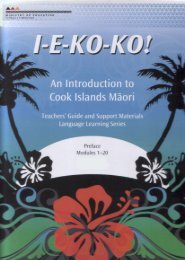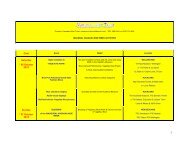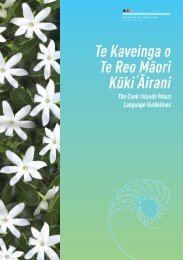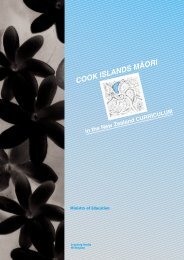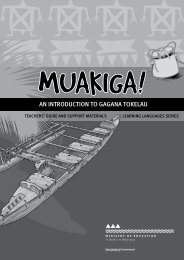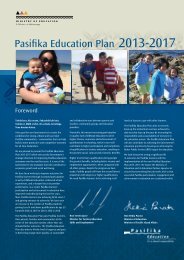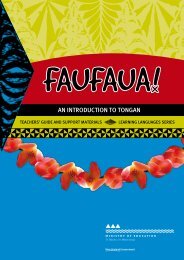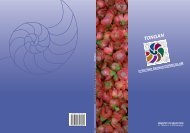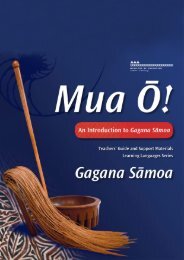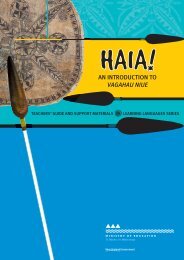Ta'iala mo le Gagana SÄmoa - Pasifika Education Community
Ta'iala mo le Gagana SÄmoa - Pasifika Education Community
Ta'iala mo le Gagana SÄmoa - Pasifika Education Community
You also want an ePaper? Increase the reach of your titles
YUMPU automatically turns print PDFs into web optimized ePapers that Google loves.
Ālāfua, Sini, ma Fuafa‘atatauStrands, Goals, and Learning OutcomesThe strands are:Ola Lau<strong>le</strong><strong>le</strong>iWell-being• The health and well-being of the child are protected and nurtured.Fa‘asinomagaBelonging• Children and their families feel a sense of belonging.Ola TautuaContribution• Opportunities for <strong>le</strong>arning are equitab<strong>le</strong>, and each child’s contribution is valued.Feso‘ota‘igaCommunication• The languages and symbols of their own and other cultures are pro<strong>mo</strong>ted and protected.Ola Su‘esu‘eExploration26• The child <strong>le</strong>arns through active exploration of the environment.Each strand has several goals. In Te Whāriki, <strong>le</strong>arning outcomes have been developed for each goalin each of the strands so that the whāriki (fala) becomes an integrated foundation for every child.The outcomes are indicative only; they are not absolute. Teachers are expected to develop their own<strong>mo</strong>re specific outcomes in response to children’s <strong>le</strong>arning and development. In Te Whāriki, outcomesare described as know<strong>le</strong>dge, skills, and attitudes that combine to become working theories and <strong>le</strong>arningdispositions across a range of areas.Ta‘iala <strong>mo</strong> <strong>le</strong> <strong>Gagana</strong> Sā<strong>mo</strong>a: The <strong>Gagana</strong> Sā<strong>mo</strong>a Guidelines se<strong>le</strong>cts particular goals within each strandand gives examp<strong>le</strong>s of related <strong>le</strong>arning outcomes that are significant to the development of the <strong>le</strong>arner’sunderstanding and use of gagana Sā<strong>mo</strong>a. It offers examp<strong>le</strong>s of <strong>le</strong>arning experiences through which this<strong>le</strong>arning may occur. Teachers are expected to develop their own gagana Sā<strong>mo</strong>a outcomes for all thegoals within each strand in response to a child’s individual <strong>le</strong>arning and developmental needs.Ta‘iala <strong>mo</strong> <strong>le</strong> <strong>Gagana</strong> Sā<strong>mo</strong>a: The <strong>Gagana</strong> Sā<strong>mo</strong>a Guidelines includes examp<strong>le</strong>s of the kinds of languagethat teachers would expect to hear children using in early childhood settings. These examp<strong>le</strong>s includesing<strong>le</strong>-word responses, incomp<strong>le</strong>te sentences, and sentences that are not well structured grammatically.The teacher's ro<strong>le</strong> is to help the child <strong>le</strong>arn. Where a child might say, “Fufulu lima la‘a ‘ai ” (Wash handsto eat), the teacher could respond by <strong>mo</strong>delling the correct sentence pattern, saying: “Fufulu lima ‘o<strong>le</strong>‘ātatou ‘a‘ai.” (Wash your hands; we're going to eat.)Teachers who wish to incorporate the teaching and <strong>le</strong>arning of gagana Sā<strong>mo</strong>a into early childhoodprogrammes are recommended to use Te Whāriki (as the foundation curriculum), together with Kei Tua ote Pae/Assessment for Learning: Early Childhood Exemplars and the sections on early childhood settings(pages 24–41), and Sa<strong>mo</strong>an values (pages 17–18) in this book, Ta‘iala <strong>mo</strong> <strong>le</strong> <strong>Gagana</strong> Sā<strong>mo</strong>a: The <strong>Gagana</strong>



